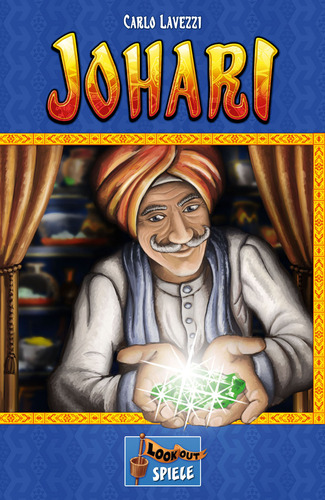This game gave me an odd sense of Déjà vu…I mean, it seemed like I had just left Jaipur having traded all my gems and acquiring a good deal of camels in the process. For those of you familiar with the two player game “Jaipur“, then you’ll know what I’m talking about. “Johari” happens to be a world famous jewelry market situated in, you guessed it, Jaipur. Your goal will be to buy and sell gems with the intent on gaining the most prestige by the end of the game. Watch out though…some of those gems are counterfeit and could land you in a bit of trouble!

Johari: 2-4 Players, Ages 10+, Average Play Time = 60 Minutes
Setup & Gameplay
Firstly, each player gets a player board and seven matching action cards of the same color. One gem token of each color is placed on the start spaces on these boards. The gem deck is shuffled and a number is dealt face-up into the store, depending on the number of players. Then, one card is drawn face-up in the bazaar stalls (the number of stalls used depends on the number of players). After that, the noble deck is constructed by randomly choosing (face-down) four cards from each of the three piles (the card backs have 1, 2, or 3 symbols on them). These twelve cards are placed on the board and two are dealt face-up on the “5” and “4” spaces. Each player placed their gold token on the 15 space on the track, stacking them in random order. Starting with the player on the bottom of the stack and going up, they’ll choose one card from either the store or bazaar to place in front of them.
The game is played over ten rounds and each round has three parts: Morning, Day, and Evening. At the beginning of each round, one card is drawn face-up for each space in the bazaar. Then, one card is drawn face-up, per player, and sorted into its spot in the store. Another noble card is drawn and the existing ones move to the right, becoming cheaper to buy.
During the Morning, Day, and Evening phases, each player will secretly choose one of their unused action cards and play it face-down, revealing them at the same time. They’ll pay the cost (minus any discounts depending on the time of day) and take the action in turn order (whoever is highest on the gold track goes first). Some actions allow players to acquire gems to place in front of them, bribe the inspector to prevent him from taking counterfeit gems you have, sell gems to either the jeweler or the collector for prestige points, and more.
As the game progresses, players will be accruing prestige points. When the last noble is placed on the track, the final round begins. After it ends, players count up how much prestige they have on their player board (per gem type) plus any cards or nobles they may have acquired. The person with the most, wins the game!
Editor’s Note: The above doesn’t cover all of the rules found in the manual, but should give you an idea as to how the game is played.
The Review
“Johari” struck me as a more complex version of “Jaipur”. In the latter, you and your opponent are fighting over cards from a central pool. You’re essentially doing the same here, but players have more options available to them. The action cards, for example, work the same way as in “Concordia”…that is, you can use them once but then get them back at a certain point (in this case, at the end of the day). That’s another thing I found interesting…the three phases of the day and how cards got cheaper to play as the day went on. Playing the purchasing card, for example, costs four gold. In the morning there’s no discount, so you’re paying full price. If you wait till afternoon however, you get a two gold discount. So there’s some strategy here, as being the richest also allows you to go first. Your opponents might opt to spend like mad and be last on the track, but they may scoop up all the good cards before you’ll have a chance to get to them.
The counterfeit gem mechanics are interesting too. Some of those gems cards can look really appealing, but you run the risk of losing a counterfeit card when someone else initiates a particular action. Scoring took some getting used to, as you either sell four gems of different types and choose one to score, or sell gems of all one type and subtracting your total sold from the person who has the second most of that gem. Prestige can be earned via cards too that come up in addition to the gems, so there are a few different paths to victory.
I personally liked this one. I like the simplicity of “Jaipur”, don’t get me wrong, but this game supports up to four players and adds a bit more oomph to the idea of selling gems for victory points. I didn’t like that the game has no box insert nor did it come with baggies for the little gems and cards. I highly suggest using some as there are a LOT of cards that’ll get flipped and mixed around while the box is closed and moved around. You can find it on Amazon for about $30, making it a tad pricey for my tastes…still, it’s worth picking up.
Final Verdict: 7/10
—
